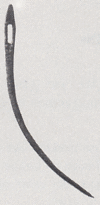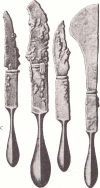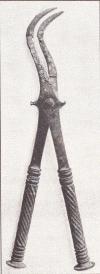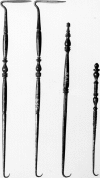Cornelius Celsus--ancient encyclopedist, surgeon-scientist, or master of surgery?
- PMID: 23344725
- PMCID: PMC3627856
- DOI: 10.1007/s00423-013-1050-0
Cornelius Celsus--ancient encyclopedist, surgeon-scientist, or master of surgery?
Abstract
Purpose: The Roman nobleman Cornelius Celsus (25 BC-AD 50) wrote a general encyclopedia (De Artibus) dealing with several subjects, among which some had medical content (De Medicina), an eight-volume compendium, including two books about surgery (VII + VIII). It is the most significant medical document following the Hippocratic writings. In 1443, Pope Nicolas V rediscovered the work of Cornelius Celsus, despite it having been forgotten for several centuries, and it was the first medical and surgical book to be printed (AD 1478). Up until the nineteenth century, 60 editions were published in Latin as well as numerous translations in European languages, the last of which was a French translation in 1876. While Celsus' work is the best account of Roman medicine as practiced in the first century of the Christian era and its influence persisted until the nineteenth century, there is controversy as to whether Cornelius Celsus himself actually practiced as a surgeon or was only an encyclopedist who collected in the Latin language the medical knowledge available at that time.
Methods: The detailed analysis of the surgical techniques described by Celsus, the modifications tailored to the findings, possible complications, detailed description of pre- and postsurgical activities, give the general impression that he himself practiced surgery at least within his family and among his dependents. In addition, his descriptions give a clear insight into the astonishingly high standard of surgical knowledge available at the time of Celsus.
Results: His work thus reflects the state of knowledge of his time, which is why he also assumed the role of teacher and scientist. As such, his meets the modern criteria addressed to a surgeon-scientist, who apart from the practical surgical activity, also had a role as teacher of surgery and scientist. Whether Cornelius Celsus had inaugurated a new surgical technique and was the first to describe that, and as such can be described as a master of surgery, cannot be corroborated.
Conclusion: Cornelius Celsus deserves a firm place in the history of surgery because with his publication De Medicina, Book VII + VIII, he has preserved Roman surgical knowledge in the first century of the Christian era and, thanks to the use of Latin in medicine and surgery, this continues to be retained up till the present day.
Figures







Similar articles
-
[Surgery in De Medicina of Celsus].Ann Chir. 1998;52(6):568-70. Ann Chir. 1998. PMID: 9752508 French.
-
The contribution of Aulus Cornelius Celsus (25 B.C.-50 A.D.) to eyelid surgery.Orbit. 2012 Jun;31(3):162-7. doi: 10.3109/01676830.2011.648816. Orbit. 2012. PMID: 22551367
-
Aulus Cornelius Celsus' De Medicina and His Contributions to Knowledge on Skin Diseases.Acta Dermatovenerol Croat. 2023 Nov;31(2):92-97. Acta Dermatovenerol Croat. 2023. PMID: 38006369
-
Aulus Cornelius Celsus and the Head Injuries.World Neurosurg. 2020 Jan;133:127-134. doi: 10.1016/j.wneu.2019.09.119. Epub 2019 Sep 27. World Neurosurg. 2020. PMID: 31568909 Review.
-
Meges of Sidon: The "Most Learned" of Surgery's Founding Fathers.World Neurosurg. 2023 Oct;178:78-84. doi: 10.1016/j.wneu.2023.07.044. Epub 2023 Jul 17. World Neurosurg. 2023. PMID: 37467959 Review.
Cited by
-
The management of elbow trauma from a historical perspective.JSES Int. 2023 Feb 2;7(6):2553-2559. doi: 10.1016/j.jseint.2023.01.005. eCollection 2023 Nov. JSES Int. 2023. PMID: 37969509 Free PMC article.
-
From NSAIDs to Glucocorticoids and Beyond.Cells. 2021 Dec 14;10(12):3524. doi: 10.3390/cells10123524. Cells. 2021. PMID: 34944032 Free PMC article. Review.
-
The history of varicocele: from antiquity to the modern ERA.Int Braz J Urol. 2018 May-Jun;44(3):563-576. doi: 10.1590/S1677-5538.IBJU.2017.0386. Int Braz J Urol. 2018. PMID: 29570260 Free PMC article.
-
Why we do what we do. A brief analysis of cancer therapies.EXCLI J. 2020 Oct 28;19:1401-1413. doi: 10.17179/excli2020-2972. eCollection 2020. EXCLI J. 2020. PMID: 33312104 Free PMC article. Review.
-
The intestinal neuro-immune axis: crosstalk between neurons, immune cells, and microbes.Mucosal Immunol. 2021 May;14(3):555-565. doi: 10.1038/s41385-020-00368-1. Epub 2021 Feb 4. Mucosal Immunol. 2021. PMID: 33542493 Free PMC article. Review.
References
-
- Stevenson R (2007) Surgery in ancient times. Proceedings of the 16th Annual History of Medicine Days. March 30 and 31, 2007 Health Sciences Centre, Calgary, AB. 237–243
-
- Ellis H. The Cambridge illustrated history of surgery. Cambridge: Cambridge University Press; 2009.
Publication types
MeSH terms
Personal name as subject
- Actions
LinkOut - more resources
Full Text Sources
Other Literature Sources
Research Materials

